In which the fruits of idleness are considered to be more precious than the fruits of labour.
By Ryan McGreal
Published March 12, 2014
I love to walk. I trek several kilometres a day, almost every day of the year, and start to get squirrelly if I go too long without moving around. That said, most of my walking is purposeful, even intense. I jaunt to work and back home, to meetings and assignments, to errands and events. Walking pleases me but I rarely walk for pleasure.
Even when I do just go for a walk, say, at lunchtime to stretch my legs and get some fresh air, I do so with a sense of urgency and impatience. After all, a lunchtime walk is really just an hour-long commute to the appointment I have with my afternoon.
Not only that, but I'm always on the lookout for material I can use to scratch the particular itches that motivate me: streets designed for cars or for people; buildings that frame or inflame their environment; and the presence or absence of trees, outdoor furniture and other creative flourishes that transform a space into a place.
So it was an unexpected pleasure to participate in the Hamilton Perambulatory Unit Km2 walk through downtown Hamilton on Saturday, March 8.
The organizer of last Saturday's event, Sarah Truman, primed us with an "enabling constraint," a delightful expression that I can't wait to employ in my own thinking. Her enabling constraint was this: we should approach our walk as flâneurs - people strolling, sauntering, loafing around the city in order to experience and reflect upon its minutiae.
The original flâneurs were 19th century French intellectuals who wandered aimlessly through the city with a level of detachment that allowed them to consider and pronounce on it.
Truman quoted the Romantic literary critic Walter Benjamin, who famously said, "The fruits of idleness are more precious than the fruits of labour." I took it as a mission to try and unpack this aphorism during the walk. (And yes, I'm aware of the irony of seeing such a saying and immediately going to work on it.)
The group to which I belonged left the Hamilton Artists Inc building at James and Cannon and drifted west on Cannon, dragged along in the slipstream of cars and trucks hurtling down one of Hamilton's worst traffic sewers. We almost immediately stumbled on a fruit of idleness: a core in the Core.
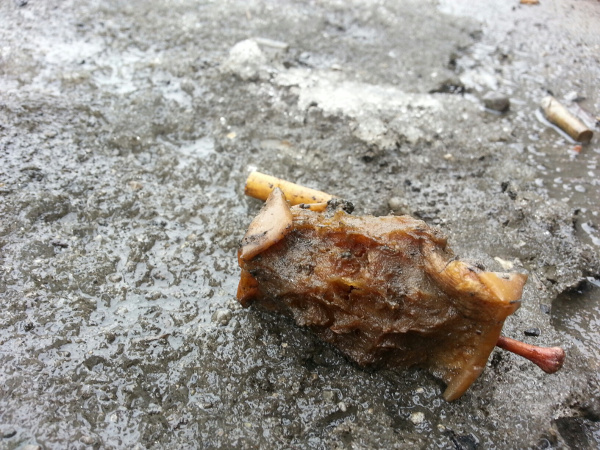
A core in the Core
Not quite what Benjamin had in mind, perhaps, but at least the street scree that emerges from beneath the receding grime-encrusted snow of late winter promises a respite from the bitter cold. It has been a damnably hard winter - a tough slog, you might say - after years of winters so mild we had mostly managed to forget we live in a northern climate.
The receding snow also serves as a striptease for the fallow green spaces that punctuate and enliven the grey gruel of our built environment during the more hospitable seasons.
There's not much more dispiriting than a "nature band-aid", as James Howard Kunstler calls the cynical interjection of perfunctory green stuff slapped onto banal architecture. But on the other hand there's not much more enlivening than a genuine garden shoehorned and cultivated lovingly into an unclaimed sliver of space, like idiosyncratic marginalia doodled on the manuscript of the city.
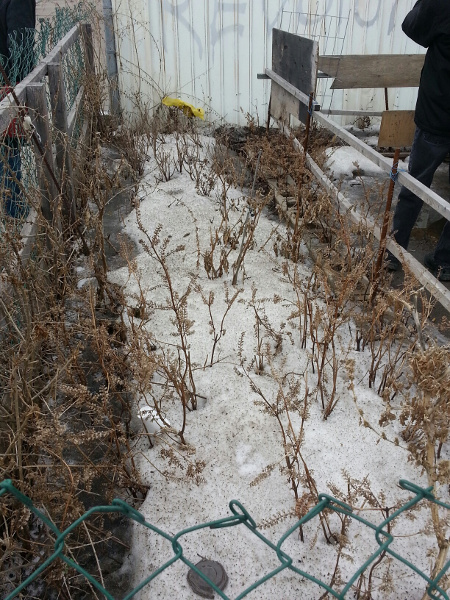
Pocket garden
If I had been striding as I normally do, I surely would have sped right past this pocket of paradise and its promise of bounty to come. As it is, our idleness alerted us to the fruit of someone's labour.
We had no way to know whether this garden is the work of an ever-the-optimist willing new life into being, a warrior establishing a beachhead on hostile territory or just a Candide making the best of the human condition. In any case, it reminds us that even labour can feel like idleness if it is undertaken with love and not mere necessity.
We turned north on Railway Street, the western boundary of our square kilometre of range. Despite our meandering pace, the insistent logic of Cannon Street was itself a red-and-blue strobe of anxiety and I felt an immediate calm fall over me once I stepped off the thoroughfare onto the little lane.
Railway Street runs just a short block and stops at a walkway into Central Park. We skimmed the edge of the park and crossed Bay Street at Mulberry. Choosing the lesser-travelled road we continued east on Mulberry, pausing to note the accidental sculpture of an angel at the side of a work centre, accreted by chance around a utility vent.
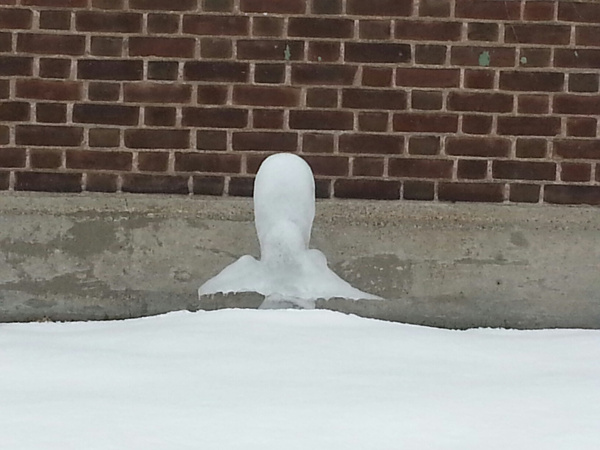
Ice sculpture
Another fruit of idleness, our ice sculpture came with the added verisimilitude of a best-before date, after which it will seep back into the earth from which it miraculously sprang, unbidden, by a happy accident of circumstance.
We strolled past a long parking lot, punctuated in the middle by a sad cluster of disused payphone booths, and turned north on Park Street. Here we found more sculptures, these ones willed into being by another labour of love: two silver dogs guarding the walkway to a small, charming house.
Again, because we were ambling rather than tromping, we had time to notice little details that spoke of care taken: eyes painted white with brown pupils, white teeth and faded red tongues.
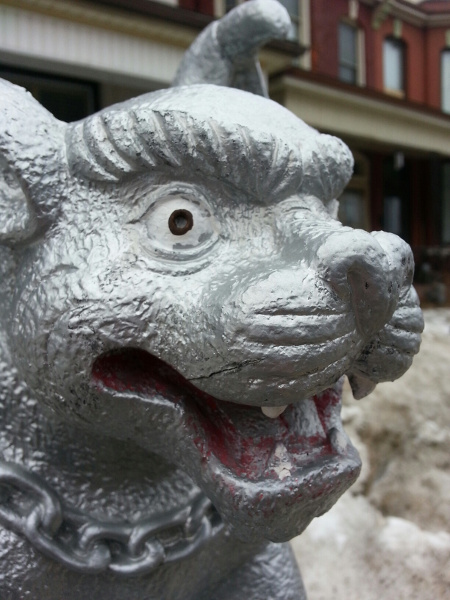
Painted statue
We continued north on Park until Colbourne, at which we turned east again, not wanting to end up on either Bay or Barton Street after our experience on Cannon.
Colbourne seems to have been relegated to the role of side street in the worst sense of the term - home to the sides of buildings and properties that face cross streets. Aside from the north side between Park and MacNab, Colbourne plays like a jumble of discarded notes rather than a composition.
Then, when we got close to James again, we caught a glimpse into the internal courtyard of the building on the southwest corner of James and Colbourne.
Cities are messy, overlapping aggregations of public and private space, and at their most interesting the hidden hearts of city blocks are home to secret passages and magical assembly halls of unlikely players performing inscrutable roles.
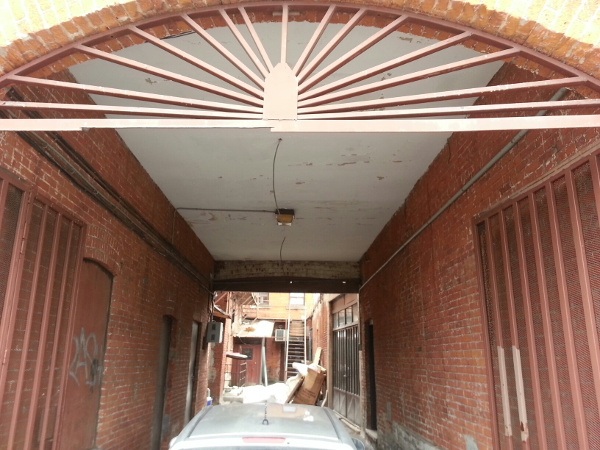
Interior courtyard
We stopped at the Faema Cafe and had surprisingly good (and surprisingly inexpensive) cappuccinos. In the spirit of French urban living, we enjoyed our drinks for a while in place before setting out again.
The last time I was in Paris, I noticed that some cafes had an option to take one's coffee in a disposable cup à emporter (a lamentable concession to creeping Americanization) but it was not encouraged, and most people still enjoyed their coffee seated in chairs pointed toward the street to watch the parade of city life.
We turned north on James and made our way toward the location of the new James North GO Station, which just broke ground and is expected to reach a Minimum Viable Product stage in time to disgorge soccer fans at the 2015 Pan Am Games.
Of course, it is impossible to stand that close to Liuna Station, the former Canadian National Rail station-turned-banquet hall that was the gateway for so many thousands of people to move to Canada from distant countries, and not muse about the changing quality of civic infrastructure over the past century.
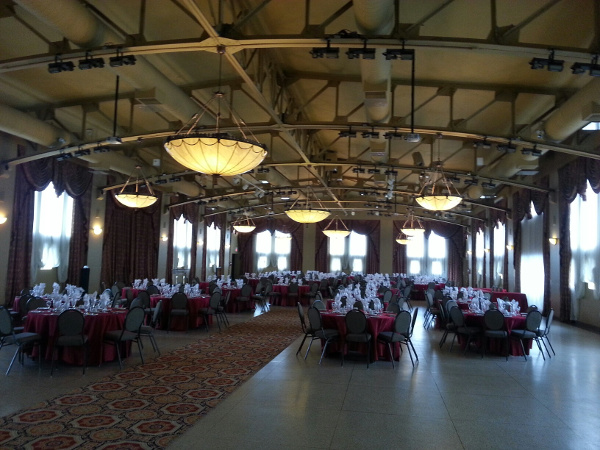
Liuna Station ballroom
Will people look back 90 years from now and marvel at the beauty and elegance of our GO Train station? Will it be amenable to adaptive reuse if and when our patterns of movement around the city, region and country change again?
It seems paradoxical that the Canada of 1929 designed and constructed the gorgeous neoclassical building that stands at 360 James Street North, while most of the institutional buildings that we, a far richer society, make today look "like fertilizer factories," to borrow an expression from Transport Minister Glen Murray when he was here a week ago Friday.
I find myself thinking that poor civilizations cannot afford the luxury of disposable architecture (or disposable coffee cups, for that matter). I really do worry about the fate of our strip malls, box stores and serpentine crescents lined with prefab houses. I worry that the things we're building today won't possibly be adequate to serve the needs of our children, and they will look upon the sagging remains of the past 60 years and think of us with scorn and contempt.
We're so very busy, but we leave so little of substance behind us.
From there we turned south again and returned to Hamilton Artists Inc for the wrap-up, making a stop along the way at a gallery owned by a friend of ours.
It occurs to me that a flâneur can be someone seeking a middle ground, a Venn overlap, or perhaps a superposition, between the detachment of passive spectators and the brisk, eusocial activity of workers engaging in their business.
A flâneur participates, after a fashion, in the comings and goings of city life without actually contributing to the industrial economy in a functional sense.
That seems off-putting, even perverse. Most of us cannot afford to indulge flânerie most of the time, and the thought of someone just wandering around all day doing nothing must fill even the most bohemian urbanist with a measure of disgust.
But a narrow functionality misses so very much about what draws people to cities and makes their various aggravations worth tolerating. A city cannot be just a collection of machines for living in, as Le Corbusier, the accidental sculptor of countless horrible 20th century urban projects, spent his career trying to insist.
A city's contents cannot be separated and arranged like the portions of pureed food in a partitioned bowl for a picky toddler. It must be innovative, recombinatory and messy. It must balance the comforting with the unexpected. It must frame people's lives in a way that makes them feel a sense of belonging and happiness. Above all it must be humane.
A city is made up not of a few big things but a huge number of little things done right, arranged just so. You cannot see little things if you speed past them too quickly, and it might just take the habit of a flâneur to slow down enough that we can pay attention to them.
As a lifestyle, flânerie seems insufferable. But as an occasional activity undertaken in a thoughtful manner, it can help us to see a familiar place from a different angle, at a different speed, and with a different cognitive frame of reference.
And in so doing, we can start to focus on what we need to do to restore our communities, one sliver of place at a time.
The next Hamilton Perambulatory Unit walk is this coming Saturday, March 15, 1:00 PM at the Inc, and will be hosted by Donna Akrey.
By Mal (anonymous) | Posted March 12, 2014 at 14:08:29
Having lived, worked and walked in the core for decades, the minutiae and history of the streets is entirely familiar. It's encouraging that city-friendly folk from outside the downtown are visiting and looking around, visiting outside of the workdays and occasionally after sunset, spending money and time on the heart of the city. Hopefully one day soon it won't be a novel intellectual exercise.
By Core-b (registered) | Posted March 13, 2014 at 10:56:15
A beautifully written article. Other than the usage of some words I had never heard before :-) I almost felt as if I was with you. I especially liked the reference to Cannon St as one of Hamilton's worst traffic sewers. Perhaps the soon to be (hopefully) bicycle lanes will improve the sewer. Unlike you, we have the luxury of walking for pleasure in the core. There's always a new discovery. The latest was the building directly north of the Freeway Cafe at Wellington and King. The building is being completely repurposed into lofts.
By StevenWatts (registered) | Posted March 13, 2014 at 17:35:46
Love the idea of being a tourist in your own city. It's interesting what you notice when walking around the city. On my regular route, new things (like graffiti or flowers blooming) really stand out. Although my route might be routine, the scenery often changes making for a somewhat new experience every time.
By Marcus (anonymous) | Posted March 14, 2014 at 15:35:05
The ideation of avoiding Barton is typical Hamiltonian, however anyone who knows the north end at all wouldnt "avoid" this area, some true architectural gems and grand homes are on this section of Barton/Colboune and Park St. Colbourne is mostly 1 sided, I used to rent on the street however the other side is home to probly some of the largest/oldest most beautiful trees in Hamilton, that section is almost tree covered in the summer!
By Angelune (registered) | Posted March 17, 2014 at 14:58:15
"idiosyncratic marginalia doodled on the manuscript of the city" whoa, just... whoa
By Missy2013 (registered) - website | Posted March 20, 2014 at 11:12:11
Lovely.
Immediately 'pinged' to two other current cultural initiatives that promote well-being: book crossing and the 'values' project.
In book crossing, a book is left in a public space so that someone else can read/share and have it. This title can be 'recycled' into another public space, or a new book title can be left. Round and round it goes ... A small civic gesture that reverberates ad infinitum.
In the values project, words like 'respect', 'kindness', 'joy' and 'integrity' are stenciled onto public roadways and/or sidewalks, with acrylic paint. Weather eventually erodes the lettering, but in the interim, the 'values' linger as a reminder of our civic commons .. O'joy.
You are a gem Ryan. A Hamilton voice For Good. Thank you.
You must be logged in to comment.
There are no upcoming events right now.
Why not post one?